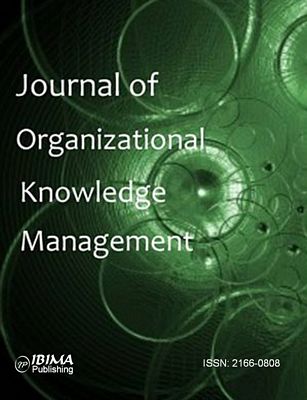Introduction
In the year 1994, the Occupational Safety and Health Act 1994 (OSHA 1994) was introduced in Malaysia. It heralded a shift from the traditional command and control method of enforcement in which the government, from the traditional command through the Department of Occupational Safety and Health (DOSH), assumed a huge responsibility in regulating the safety and health of workers at the workplace to one of self-regulation, wherein all stakeholders at the workplace would assume responsibility for safety and health at the workplace with ultimate responsibility vested in the employer (Yon, 2007; Soehod, 2007).
Underlying the self-regulation concept are the twin principles of employee involvement and joint commitment from management and employees (Levinson, 1987). The Roben’s Report completed in 1972, in the United Kingdom (Beck & Woolfson, 2000) is credited with promoting self-regulation as a regulatory system; hence the term Roben’s Model.
However, it has been argued that the Roben’s Model merely emphasized the need for employee consultation in advocating self-regulation without perpetuating a specific form of employee involvement (James & Kyprianou, 2000; James & Walters, 2002). Self-regulation has been institutionalized via legislative initiatives in a number of countries such as the United Kingdom, Canada, Australia and New Zealand to name a few.
In comparison to those countries, it can be observed that Malaysia has adopted this concept of self-regulation (Yon, 2007; Soehod, 2007) approximately two decades after it came into fashion in the 1970s.
It is argued that the institutionalization of the concept of self-regulation varies from one country to another (Hovden, Lie, Karlsen & Alteren, 2008). The differences are discerned in the varied ways the twin principles of self-regulation are manifested in terms of coverage and functions:
(i) whether the establishment of occupational safety and health committees (OSHCs) that comprise of management and non-management representatives is dependent upon certain factors (size of firm, type of industry etc.);
(ii) whether OSHCs are a distinctive feature of the self-regulatory system;
(ii) the extent of rights and powers vested in members of OSHCs.
For example, in Canada the presence of an OSHC features distinctively in its self-regulatory system (O’Grady, 2000), but the same cannot be said of the situation in the United Kingdom. In the latter, according to Wright and Spaven, (1998) the form of employee involvement is dependent upon the type of workplace (unionized, non-unionized and offshore).
Legislative impetus in the United Kingdom necessitates the requirement for trade union appointed health and safety representatives that may lead to the establishment of OSHCs in the unionized workplace and the establishment of OSHCs in the offshore workplace. With respect to non-unionized workplaces, the employer determines the form of employee involvement whereby direct or indirect consultations are available options (Walters, 1997).
In addition, the role and functions of members of OSHCs may vary depending upon country origin (Hovden et al., 2008) and even within different jurisdictions in the same country (O’Grady, 2000).
In Malaysia, via section 30 of the OSHA 1994, workplaces with 40 or more employees are mandated to establish OSHCs. In addition, Regulation 5(2) of the Occupational Safety and Health (Safety and Health Committee) Regulations 1996 (OSHCR 1996) stipulates that the composition of OSHCs must at the very least have an equal number of management and non-management representatives implicitly underlying the joint nature of OSHCs.
A collective perusal of the OSHA 1994 and the OSHCR 1996 prompts one to conclude that the OSHC is a distinctive feature in the OSH self-regulatory system adopted in Malaysia. The justification for OSHCs is based on the theory that occupational safety and health are best achieved through empowering managers and non-managers at the point of production to enforce compliance with standards. In many industrialized countries they are regarded as the cornerstone of safety and health policies (Eaton & Nocerino, 2000).
The concept of empowerment that enfolds the OSHC is recognizant of the indigenous knowledge of the non-management member of the OSHC and thus thrusts him/her in the role of a knowledge worker to a certain extent regardless of the actual job function undertaken.
Thus, it would be apt to determine whether the functionings of an OSHC can be conceptualized through the lens of knowledge management, and to determine after a span of fifteen years from the passing of the OSHA 1994, the type of OSHC activities that are lagging in terms of knowledge creation. This would enable employers, policy makers, professionals in safety and health and organizational designers to view the OSHC in a different light. In addition, the assessment of the OSHC as a potential knowledge creation vehicle in the area of OSH at the work place may validate its centrality in the Malaysian self-regulatory model.
A discovery of the types of activities relatively least performed by OSHCs despite legislative sanctions may also be indicative of the extent of employee involvement and hence the pulse of the self-regulatory system in Malaysia, and reflective of whether the path towards a systems approach in Malaysia (Soehod, 2007) would be smooth or strewn with impediments along the way. A systems approach is defined by Bakri, Mohd Zin, Misnan and Mohammed (2006) as a planned, documented and verifiable method of managing hazards and risks at the workplace in a systematic way and is part of the overall management system.
They argue that such a system will enable firms to comply with their duties under the OSHA 1994. However, the success of a systems approach is dependent upon varied factors one of which is employee involvement (Saksvik & Quinlan, 2003).
The focus has been on manufacturing firms because the Social Security Organization’s Annual Report of 2009 and the DOSH Annual Report of 2009 indicate that the manufacturing sector has the highest number of accidents compared to other sectors.
Literature Review
The literature review elucidates the following observations, concepts and theories:
(i) legislative impetus does not translate readily into practice;
(ii) knowledge management can result in generation of knowledge asset;
(iii) knowledge management is dependent upon enabling factors.
Tension between Law and Practice in the Role and Function of OSHCs
Countries that absorbed the spirit of the Roben’s Model acknowledged the importance of employee involvement in their adoption of the self-regulatory system in the area of occupational safety and health.
This was actualized either via legal provisions relating to the establishment of OSHCs, the role and function of OSHCs through safety representatives or provisions emphasizing the need for consulting with employees (regardless of form of consultation) in stipulated areas. Studies have been conducted in the United Kingdom by James and Kyprianou (2000), James and Walters (2002) and Walters and Nichols (2006) show a tension between legislative impetus and implementation attributable to varied factors noted in James and Kyprianou (2000) and Walters (1995) such as the following: power relationships between managers and workers; approach adopted by enforcement agencies, workplace size and origin, degree of trade unionization, industrial sector and the political, social and economic climate within which it operates. Some of the studies reviewed by O’Grady (2000) also lend credence to the fact that a tenuous relationship between legislative impetus and implementation may also prevail in other countries that have imbibed the spirit of the Roben’s Model.
This possibility may have inspired the study by Nichol, Kudla, Manno, McCaskell, Sikorski and Holness (2009) who discovered that joint OSHCs that had been legislatively sanctioned for more than thirty years in Ontario, Canada were functioning well in acute care hospitals in terms of legislative compliance and availability of resources and experts.
However, gaps in functioning were noted in the following areas: lack of joint OSHC member education beyond certification training and suboptimal status and visibility of joint OSHCs within the organization.Thus it is invaluable to determine how OSHCs in Malaysia were functioning in terms of legislative compliance.
Knowledge Management Producing Knowledge Assets in the Context of OSHCs
Goel, Sharma and Rastogi (2010) extol the three main benefits of knowledge management; and define knowledge management as a term to loosely refer to the broad collection of organizational practices and approaches related to the generating, capturing and disseminating knowledge relevant to firms’ business.
One of the three benefits of knowledge management as extolled by Goel et al. (2010) is the critical role that knowledge management can play in the strategic management of human capital and leverage its knowledge base for business performance and improvement.
Given the justification for the establishment for OSHCs as mentioned in the earlier part of the paper that is to draw out and utilize the indigenous knowledge of non management employees for the improvement of OSH at the workplace, it is argued that knowledge management has a critical place in the activities of OSHCs.
Chen, Huang and Hsiao (2010) in their study find that knowledge creation and knowledge sharing, the twin pillars of knowledge management, are drivers of organizational innovativeness; and that the relationship between the two ‘drivers’ and that of organizational innovativeness can be moderated by organizational climate (supportive climate, innovative climate) or organizational structure (less formalized, less centralized and more integrated). The concept of innovativeness has been defined by the authors as, ‘propensity for a firm to develop new elements or a new combination of already known elements in products, technologies or management. It involves the acquisition, dissemination and use of new knowledge’.
Thus innovation in the manner defined is a potential outcome of the activities of OSHCs as legislated in Malaysia in the context of improving workplace occupational safety and health (see Table 2); and prompted the researcher to view the activities from the lens of knowledge management theories and concepts.
Lin and Wu (2005) conceptualize the creation of knowledge via the ISO 9001: 2000 quality management system. They were able to specify knowledgeable quality information and its manner of conversion into quality knowledge via the appropriate activity that takes place in a particular context resulting in a type of knowledge asset.
Several modes of conversion are noted: socialization (sharing of tacit knowledge; for example, interaction with customers and supplier), externalization (tacit to explicit; for example, writing to articulate tacit knowledge), combination (explicit to explicit whereby explicit knowledge becomes more complex) and internalization (explicit to tacit; for example, actualizing work practices). The contexts in which an activity with knowledge creating potential takes place are conceptualized as follows: originating (individual and face to face interaction), dialoguing (collective and face to face interaction), systemizing (collective and virtual interactions) and exercising (individual and virtual interactions).
Four types of knowledge assets are identified: experiential (skills and know-how), conceptual (concepts or designs), systemic (product specification, manual and documented information) and routine (actions and practices). The conceptualization of the knowledge creation process in the context of quality management led the researcher to query its applicability in the context of the workings of an OSHC.
Enablers of Knowledge Management in General
A plethora of studies have focused on varied factors (strategy and leadership, corporate culture, people, information technology) that enable knowledge management. Yeh, Lai and Ho (2006) in their case study of two companies were able to verify the academic theories relating to knowledge management enablers with real practice in the industry. They discovered that for the strategy and leadership enabler the formation of a culture of sharing is important; for the corporate culture part, it is important to form a culture of sharing that is supplemented by IT; for the people enabler part, channels of learning and incentive programs are important in addition to training courses; for the IT enabler factor, it is important to ensure speedy search of knowledge for its re-use other than the mere digitization of knowledge.
Premised upon the argument that OSHCs are channels of knowledge management, it is argued that these enablers may have an impact on the knowledge management activities of OSHCs.
King, Kruger and Pretorius (2007) affirm the multitude factors that act as knowledge management enablers but argue persuasively that culture is the decisive factor in successful knowledge management systems; and that inculcating a knowledge sharing culture in a diversified environment is not an easy task.
In their study, King et al. (2007) discovered via their single case study of a diversified work environment that several factors (language barriers, discrimination, individual based educational systems) could impede knowledge sharing that is a precursor to knowledge creation. The said study was compelling as the Malaysian workplace comprises a heterogeneous workforce in terms of ethnicity, educational background and language spoken, and the barriers discovered in the said study may explain ineffective knowledge sharing among members of OSHCs.
Study Objectives and Questions
The purposes of the study are twofold:
(i) to determine the type of knowledge assets created via the activities of OSHCs that are regulated by the OSHCR 1996 and
(ii) to determine the type of OSHC activities that have not been extensively tapped in the creation of knowledge. In relation to these two objectives, the two research questions formulated are as follows:
1.What are the types of knowledge assets that can be created through the activities of OSHCs in Malaysian manufacturing firms?
2.What are the types of OSHC activities that have not been extensively tapped in the creation of knowledge to improve OSH at the Malaysian manufacturing workplace?
Methods
To answer the first question, the Knowledge Creation Model for ISO 9001:2000 conceptualized by Lin and Wu (2005) is used. In their paper, they explicitly define the concepts and elucidate how every activity in the ISO 9000:2000 Quality Management System is tied to knowledgeable quality information. Every activity takes place in a given type of context whereby the said context allows every activity to be converted to quality knowledge through a specific knowledge converting mode. The end result would be a type of knowledge asset that enables the improvement of quality management at the workplace. In the same vein, activities of the OSHCs as regulated by the OSHCR 1996 were analyzed but placed within the context of improving occupational safety and health (OSH) at the workplace.
To answer the second question, a questionnaire survey was conducted using the sampling frame of all Malaysian manufacturing companies with OSHCs (4, 337) provided by DOSH in September 2008. One thousand survey packages were posted. Each package comprised two sets of identical questionnaires: one to be answered by a management representative (MR) and another to be answered by a non-management representative (NMR). Data was collected from April 2009 until January 2010.
Altogether 278 respondents participated in the survey: 196 MRs and 82 NMRs. The responses were evaluated statistically using SPSS software version 17.0. The final data set comprised 231 cases only as cases that were outliers were removed and if a MR and NMR originated from the same manufacturing company the NMR was eliminated from the data set. The latter elimination was done because the unit of analysis was the manufacturing company and the response of either the MR or NMR would be representative of the company.
Either response of MR or NMR would be representative of the firm because type of representative did not have a statistically significant impact upon perception of legislative compliance with OSHCR 1996 (denoted as OSHCR) because premised upon assumption of variance being violated, the p value was 0.308 (>0.05), when Independent sample t test was run.
This finding could perhaps be attributed to the OSHC operating in a different population. Perhaps in the Malaysian landscape members of OSHCs regardless of type see themselves unified for a common purpose that benefits all employee types. Stratified random sampling was the method employed and the ratio of each category to the sample matched the ratio of each category to the population whereby category refers to the type of manufacturing company.
Results and Analysis
Table 1 below displays how every activity of the OSHC is linked to specific knowledgeable quality information, and via the knowledge transformation mode becomes quality knowledge regarded as a type of knowledge asset in the context of OSH for the workplace.
The conceptual knowledge assets when acquired consists of explicit knowledge that enable the OSHCs to make recommendations that are reactive (prevent OSH issues from reoccurring) and/or proactive (prevent OSH issues from occurring) in nature.
Their acquisitions by members of OSHCs are dependent upon interaction with third parties: employees, internal experts and external experts. It is thus argued that the prevalence of the conceptual asset type enables OSHCs to be aware of the OSH environment at the workplace and simultaneously to be at the forefront of current knowledge in the field of OSH and thus be able to make appropriate recommendations in the context of the workplace.
Table 1: Knowledge Created within OSHCR 1996
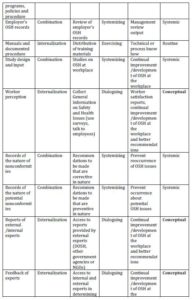
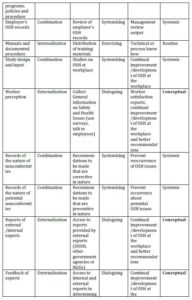
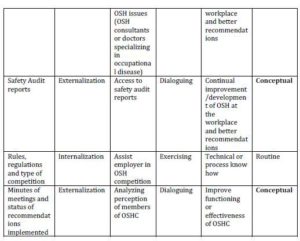
Table 2 below displays the results of the descriptive analysis. The cut-off point for the mean value is 3.5238 and below in determining which OSHC activities are lax. Based on that, yardstick committee functioning is relatively lax in several areas: access to reports provided by external experts, access to safety audits, collecting of general information on safety and health issues, assisting of employer in health and safety competitions, carrying out studies on safety and health at the workplace and access to internal and external experts in determining safety and health issues.
All the items denoted in Table 2 are the functions that are legislatively prescribed via the OSHCR 1996 and were measured using a five point Likert scale whereby respondents were ask to circle the extent to which each of the functions is carried out ranging from none (0=none) to always (5=always).
Excluding the activity of the OSHC in relation to safety competitions, all the other lagging activities are dependent upon the knowledge of third parties. In addition, they are reflective of the lack of ability in generating conceptual knowledge type asset that was argued earlier to be of importance in making the OSHC a firebrand of sorts.
Table 2: Results of Descriptive Analysis for Twenty Items on Committee Functioning
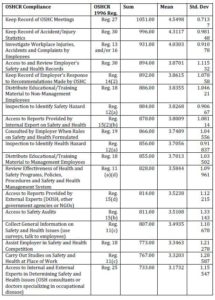
Discussion
The conceptual analysis that applied the Knowledge Creation Model conceptualized by Lin and Wu (2005) proves that the said model and its related concepts are applicable in making meaning of the activities of OSHCs. More importantly, it proves that the OSHCs have the ability to create knowledge assets that are relevant in maintaining and improving the state of OSH at the workplace. In a way, this justifies the importance of mandated OSHC as an essential feature in the shift toward self-regulation in the watershed year of 1994 when the OSHA 1994 came into being.
In addition, by viewing OSHCs as a channel for knowledge creation, members of OSHCs and employers alike would have a clearer understanding of the main functions of OSHCs and how they are inextricably linked to knowledge management. However, the empirical analysis shows that manufacturing firms in Malaysia are not extensively tapping the knowledge creation ability of OSHCs via these activities: collecting general information on safety and health issues, access to reports provided by external experts, access to safety audits, carrying out studies on safety and health at the workplace and access to internal and external experts in determining safety and health issues.
The reasons for such a state of affairs are many:
(i) top management not being committed to OSH issues in general whereby OSH issues are perceived as an expense rather than an investment;
(ii) top management being unable to appreciate the knowledge creation ability of OSHC and thus being unsupportive of it whereby its establishment is merely for the sake of legal compliance;
(iii) top management may be uncomfortable with the conceptual type knowledge assets in the form of recommendations for continual improvement that may touch upon the work environment and be proactive in nature entailing safety expenditure that is perceived by management at best based on clairvoyance;
(iv) members of OSHCs may not be motivated enough to undertake the abovementioned activities owing to lack of time or absence of incentives as legislation does not mandate that safety work would be subject to any form of remuneration whereby members of OSHCs have to carry out safety work on top of the expected workload;
(v) members of OSHCs may not be able to undertake those activities owing to financial constraints as such activities may not be budgeted for by top management.;
(vi) members may also need some training in how some of those activities need to be carried out for example how to conduct studies relating to OSH and how to collect general information.
These varied reasons can be neatly attributed to factors originating from management commitment or scope and content of training with a substantial emphasis on the former because section 30 of the OSHA 1994 in Malaysia imposes a duty upon the employer to establish OSHCs when the threshold of forty or more employees is reached at the workplace. Added to that is the imposition upon the employer of the duty to ensure that members of OSHCs have basic understanding and knowledge of functions of the committee, the duty to provide adequate training and lastly the duty to make available relevant document and information (regulations 29, 30 and 31 of the OSHCR 1996). These duties when breached would subject the person if convicted to a fine not exceeding five thousand ringgit or to imprisonment for a term not exceeding six months or to both (regulation 32 of the OSHCR 1996). However, no prosecutions have been made pursuant to the OSHCR 1996 to date as the provisions are difficult to enforce on the part of enforcement officers from DOSH. How does one determine for instance whether training provided by management to members of an OSHC is adequate? The word adequate is open to varied interpretations coloured by the employer’s perception as to what is adequate. In addition, how do enforcement officers determine whether members of OSHCs have basic understanding and knowledge of OSHC functions? This is because the basic understanding and knowledge are dependent upon employers interpretation of what amounts to basic knowledge and understanding of OSHC functions. Perhaps it can be argued that at least the duty on the part of the employer to make available relevant document and information can be enforced as the nature of the document and information have been specifically itemized in regulation 30 of the OSHCR 1996. However, how does enforcement ensure whether in actuality the relevant document and information have been made available to members of OSHC? This is because it is always possible for the employer to claim such disclosure has been made and difficult for members of OSHCs (especially those provided ‘adequate’ and ‘basic knowledge’ by the employer) to deny otherwise. More importantly, there is no obligation imposed upon the employer to maintain documents and information of the nature described in section 30 of the OSHCR 1996.
Conclusion
It is argued that the OSHCR 1996 lacks teeth; however, given the centrality of OSHCs in the OSH self-regulatory system adopted in Malaysia and the potential of OSHCs for knowledge creation in pursuit of OSH improvement at the workplace, several measures can be undertaken to address this. The suggested measures are as follows:
(i) educating employers on the benefits of investment in OSH in terms of tangible (reduction of losses attributable to OSH issues) and intangible benefits (motivated workforce);
(ii) educating employers and safety personnel in the firm as to the potential of OSHCs to act as an effective knowledge creation channel for the improvement of OSH at the workplace;
(iii) educating employers and safety personnel in the firm on the need to ensure that the factors (strategy and leadership; corporate culture, people and information technology) enabling the functioning of the OSHC as a knowledge creation model are prevalent ;
(iv) educating members of the OSHC on their role as knowledge creators that is very much dependent upon their ability to acquire and share knowledge; (v) addressing factors (language barriers, high power distance culture, discrimination and individual based educational systems) that may prevent the knowledge acquisition and sharing that ought to take place via OSHCs that are reflective of the diversity in the Malaysian workplace;
(vi) the ambiguous provisions in the OSHCR 1996 should be prescribed with clarity so that the enforcement of those provisions can be enforced confidently by DOSH enforcement officers;
(vii) provisions of incentives by DOSH be made to workplaces that have an OSHC working effectively as a knowledge creation channel;
(viii) external experts such as occupational safety and health (OSH) professionals, non-governmental organizations (NGOs) and DOSH need to initiate the networking system and utilize information communication technology (ICT) based systems creatively and effectively to allow for a continuous flow of information between OSHCs and the experts. External initiation is vital because this channel of knowledge creation in the area of OSHC has been mandated but in terms of practice is the least utilized by the OSHCs in the manufacturing firms.
An appreciation and recognition by the employer of the OSHC as a channel for knowledge creation, and effective enforcement of the OSHCR 1996 by DOSH enforcers would cloak the OSHC with the mantel of respect and authority that it requires. Only then can the suggested changes be made by the employer either willingly or upon threat of enforcement to enable the effective functioning of OSHCs as a channel for knowledge creation. Active involvement from external experts provide an added benefit in engendering the development of a knowledge activist type of member of the OSHC as envisioned by Hall et al. (2006) that would take workplace OSH to a higher level in the manufacturing firm.
References
Bakri, A., Mohd Zin, R., Misnan, M. S. & Mohammed, A. H. (2006). “Occupational Safety and Health Management Systems: Towards Development of Safety and Health Culture,” Proceedings of the 6th Asia-Pacific Structural Engineering and Construction Conference, Malaysia, C19-C28.
Publisher
Beck, M. & Woolfson, C. (2000). “The Regulation of Health and Safety in Britain: From Old labour to New Labour,”Industrial Relations Journal , 31(1), 35-49.
Publisher – Google Scholar – British Library Direct
Chen, C.-J., Huang, J.-W. & Hsiao, Y.-C. (2010). “Knowledge Management and Innovativeness: The Organization Climate and Culture,” International Journal of Manpower , 31(8), 848-870.
Publisher – Google Scholar
Department of Occupational Safety and Health. Annual Report. Kuala Lumpur. (2009)
Eaton, A. E. & Nocerino, T. (2000). “The Effectiveness of Health and Safety Committees: Results of a Survey of Public -sector Workplaces,” Industrial Relations , 39(2), 265-288.
Publisher – Google Scholar – British Library Direct
Goel, A.K., Sharma, G. R. & Rastogi, R. (2010). “Knowledge Management Implementation in NTPC: An Indian PSU,”Management Decision , 48(3), 383-395.
http://dx.doi.org/10.1108/00251741011037756
Publisher – Google Scholar
Government of Malaysia. Occupational Safety and Health Act (Act 514) 1994
Publisher
Government of Malaysia. Occupational Safety and Health (Safety and Health Committee) Regulations 1996
Hall, A., Forrest, A., Sears, A. & Carlan, N. (2006). “Making a Difference: Knowledge Activism and Worker Representation in Joint OHS Committees,” Industrial Relations/Relations Industrielles, 61(3), 408-436.
Publisher – Google Scholar – British Library Direct
Hovden, J., Lie, T., Karlsen, J. E. & Alteren, B. (2008). “The Safety Representative under Pressure. A Study of Occupational Health Safety Management in the Norwegian Oil and Gas Industry” Safety Science , 46, 493-509
Publisher – Google Scholar
James, P. & Kyprianou, A. (2000). “Safety Representatives and Committees in the NHS: A Healthy Situation?,” Industrial Relations Journal , 31(1), 50-61.
Publisher – Google Scholar – British Library Direct
James, P. & Walters, D. (2002). “Worker Representation in Health and Safety: Options for Regulatory Reform,” Industrial Relations Journal , 33(2), 141-156.
Publisher – Google Scholar – British Library Direct
King, N., Kruger, N. & Pretorius, J. (2007). “Knowledge Management in a Multicultural Environment: A South African Perspective,” Aslib Proceedings: New Information Perspectives. 59(3), 285-299.
Publisher – Google Scholar – British Library Direct
Levinson, A. (1987). “Self-regulation and Health and Safety,” ‘Employee Relations’, 9(4), 3-8.
Publisher – Google Scholar
Lin, C. & Wu, C. (2005). “A Knowledge Creation Model for ISO 9001:2000,” Total Quality Management , 16(5):657-670.
Publisher – Google Scholar – British Library Direct
Nichol, K., Kudla, I., Manno, M., McCaskell, L., Sikorski, J. & Holness, D. L. (2009). “Form and Function of Joint Health and Safety Committees in Ontario Acute Care Hospitals,” Healthcare Quarterly, 12(2), 86-93.
Publisher – Google Scholar
O’Grady, J. (2000). “Joint Health and Safety Committees: Finding a Balance,” In Terrence Sullivan (ed.), Injury and the new world of work. Vancouver: UBC Press . pp. 162-197.
Publisher – Google Scholar
Saksvik, P. O. & Quinlan, M. (2003). “Regulating Systematic Occupational Safety and Health Management: Comparing the Norwegian and Australian Experience,” Industrial Relations, 58(1), 33-59.
Publisher
Social Security Organization. Annual Report. Kuala Lumpur. (2009)
Soehod, K. (2007). ‘Law on Safety and Health in Malaysia,’ Unpublished manuscript, Universiti Teknologi Malaysia.
Walters, D. (1995). “Employee Representation and Occupational Health and Safety: The Significance of Europe,” J. Loss Prev. Process Ind., 8(6), 313-318.
Publisher – Google Scholar – British Library Direct
Wright, C. & Spaven, M. (1998). “Who Represents Whom? The Consequences of the Exclusion of Unions from the Safety Representation System in the UK Offshore Oil and Gas Industry,” Employee Relations, 21(1), 45-62.
Publisher – Google Scholar – British Library Direct
Yeh, Y.-J., Lai, S.-Q. & Ho, C.-T. (2006). “Knowledge Management Enablers: A Case Study,” Industrial Management & Data, 106(6),793 810.
Publisher – Google Scholar – British Library Direct
Yon, H. (2007). “Factors Associated with Chemical Safety Status in Small and Medium Printing Enterprises in Penang,” Unpublished Master’s thesis. Universiti Sains Malaysia.
Publisher – Google Scholar



